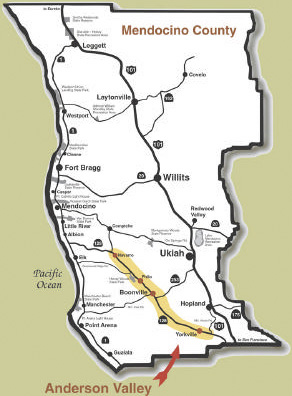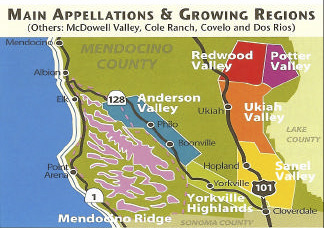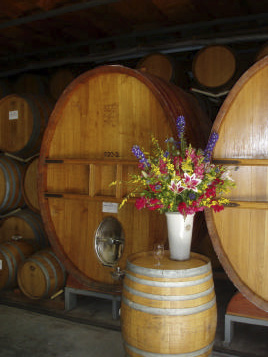Anderson Valley has Baul Hornin’
There are eleven grape-growing appellations in Mendocino County, California, but it is the Anderson Valley
that is uniquely suited to growing that minx of a grape, Pinot Noir. Plantings of Pinot Noir in Mendocino County
(1,930 acres) are overshadowed by other varietals such as Chardonnay (4,336 acres), Cabernet Sauvignon
(2,559 acres), and Zinfandel (2,072 acres). The history of winegrowing in Mendocino County is linked most
closely with Parducci (the oldest winery in the region dating to 1931) and Fetzer (dating to the late 1960s) who
flooded the market through the years with wines of reliable value from the warmer areas of Mendocino County
outside the bounds of the Anderson Valley. Anderson Valley has achieved its own notoriety through the production of super-premium artisan Pinot Noirs, crisp Alsatian whites (Riesling, Pinot Gris, and Gewürztraminer), and superb sparkling wines.
The Anderson Valley is a relatively isolated area bordered on two sides by 1000+ foot mountains and located
15 miles from the Pacific Ocean at its northern tip or “deep end.”. The valley floor is about 18 miles long and
opens on its northern end to the Pacific coast via the Navarro River Canyon. This unique topography allows
morning fog to roll into the valley and gentle breezes to enter in the afternoon. A gradient is created, with the
northern ocean end, referred to by locals as “down-valley,” receiving more rain and fog and thus being cooler,
and the southern inland portion, or “upper- valley” being typically 8-10° warmer. The valley’s vineyards and
wineries are clustered along the fringes of Highway 128, which bisects the valley, with a majority of them located down-valley. Along Highway 128, the vineyards begin at the town of Boonville, continue north through
Philo, and end in the tiniest hamlet of the three, Navarro (see map, page 2). Continuing north, Highway 128
travels a circuitous and twisting, but scenic, route to the Pacific Ocean.

Most visitors access the Anderson Valley via Highway 128 as it departs westward from Highway 101 at
Cloverdale, 80 miles north of San Francisco. (Do not be confused by Highway 128 East which you approach
first heading north that takes you to Guerneville). Once on Highway 128 West, you quickly enter
a pastoral land of great beauty and your pulse seems to slow with each mile you travel (that is, if
you don’t encounter a lumber truck coming south on the narrow two-lane highway!). You leave the
world of roadside McDonalds and gas stops and encounter a countryside teaming with moss-covered
majestic oaks, towering redwoods, ramshackle old barns, and calmly grazing sheep and cows. In 30
minutes you come to Yorkville, the town center of the Yorkville Highlands AVA, tucked between the
Anderson Valley to the northwest and Alexander Valley to the southeast at the headwaters of the Russian
River. There are 22 vineyards located here at higher elevations (most are between 1,000 and
2,200 ft) and planted primarily to red varietals including some Pinot Noir. Another 15 minutes of
driving brings you into Boonville, the center of “activity” in the valley. About 3,000 people are scattered
throughout the valley, a fourth of them calling Boonville home.

The Anderson Valley will never become another Napa Valley simply because retirees and urban refugees
with money seeking the wine lifestyle won’t find the creature comforts here. In a recent article in
Wine Enthusiast Online titled “The Price of Dirt”, authored by Roger Voss and Kathleen Buckley, a
realtor who sells vineyard estates and wineries in Sonoma County (John Bergman) points out that “an
essential factor in deciding where to buy is the restaurant scene. For the lifestyle, you have to have all
the attributes, the finest restaurants, the finest wineries, and finest hotels. That rules out vineyards in
marginal lifestyle areas, no matter how nice the trophy house.” Boonville has only three restaurants, a
fine restaurant at the Boonville Hotel featuring California-style cuisine prepared by talented chef
Johnny Schmidt, the Redwood Drive-In Café, and Libby’s, a small but popular Mexican restaurant. The
gourmet restaurants of Mendocino and Fort Bragg are a 45 minute drive away. I was in a buffet line at
a barbecue while recently visiting Anderson Valley, and stretching my neck to view the dessert table,
I remarked, “There is only one dessert.” One of the locals turned around and said to me, “Hey, this is
Mendocino, not Napa!).
Boonville is known as Boont in the local language of Anderson Valley called boontling. In the 1800s,
an indigent and secretive code-like dialect became the spoken word for many of the valley residents.
The exact origins are unclear, but many attribute the beginnings to the mothers and children who
worked in the hop fields prevalent in the valley at the time. The isolation of the valley and the distrust
of city people (“brightlighters”) fostered the language. Terms included “baul seep” (lovers of wine),
“baul hornin’” (good drinking), “Frati” (wine - Mr Frati was a local vineyardist), Frati shams (wine
grapes), “breggo” (sheep), and “backdated chuck” (someone who is behind the times). Many of the
words had their origins in language of the Scottish, Irish, Spanish, and Pomo Indians (the original settlers
of the valley). Today, fragments of boontling remain as slang terms. One word of caution if you
visit: if you don’t want to incur the wrath of locals by appearing to be a raging brightlighter, leave
your designer jeans, Louis Vitton bags, and Polo shirts at home.
The Pomo tribe were the original Native American inhabitants of Anderson Valley. Among the first
white settlers here in 1851 was the Anderson family. Walter Anderson planted the first apple trees in
the valley. Soon, hop fields were ubiquitous and a thriving timber industry developed. The 1960s
brought an influx of hippies drawn to the beauty and isolation of the valley. During the 1970s and
1980s, urban refugees bought ranches and replaced apple orchards with vineyards. The latest newcomers
to the valley are Mexican laborers valued for their work in the vineyards. Olives are the newest
crop and several olive oil producers including well-regarded Stella Cadente have appeared.
In the late 1800s, Italian immigrants came to Mendocino from San Francisco and had success growing
grapes above the valley along the Greenwood Ridge. In the 1940s and 1950s, attempts to grow grapes
in the valley by Asti, Goodhue, and Pinoli were largely unsuccessful because of problems with ripeness
and frosts. The modern history of winegrowing in the Anderson Valley is linked to four names:
Edmeades, Husch, Lazy Creek and Navarro. In 1963. Dr. Donald Edmeades, a Pasadena, California
cardiologist, purchased land north of Philo. He planted his first 24 acres in 1963. The locals were quite
skeptical, and Edmeades, in good humor, put up a sign on Hwy 128 that read “Edmeades’ Folly.” He
had, in fact, carefully researched the potential for grape growing in the valley. At the time, the University
of California Davis viticulturalists had completed a survey of the valley and classified the lower
valley between Philo and Navarro as Region I (the coolest for grape growing and the location of
Edmeades) and the upper valley around Boonville as cool Region II. Edmeades had success growing
Chardonnay and Gewürztraminer, but unfortunately, he passed away from cancer just after his winery
was built in 1972. His son Deron took over and made the first vintage. Edmeades (now part of Kendall-
Jackson and closed to the public), has achieved notoriety with Zinfandel grown in Mendocino
County. Edmeades was never a major player in the Pinot Noir game.
The first Pinot Noir planted in the Anderson Valley was by Husch Vineyards in 1968. Founder Tony
Husch had been exposed to Pinot Noir by John Parducci. A 3-acre parcel of the estate known as The Knoll was chosen. Located on a hillside overlooking the Navarro River, it was planted to a Wente field
selection. The first harvest was in 1971. Long-time vineyard manager, Al White, arrived in 1973. As Al
recounts his first harvest at Husch in 1974, one is struck by the archaic vineyard management of the
time. The vines were planted with 8 ft by 12 ft spacing with overhead irrigation. Trellising was
minimal and no leaf pulling was done. Rain at harvest was a problem and with it came mold which was
a significant nuisance. The grapes were picked to apple boxes at a very casual pace over several days
by a hippie crew! The Knoll Vineyard is still producing Pinot Noir, but has been transfigured by more
modern viticulture practices.
The third noteworthy modern winegrowing pioneer in the Anderson Valley was a restaurateur from
San Francisco, Johann Kobler and his wife Theresia. He purchased the 20-acre Lazy Creek Vineyards
in 1969 from the Pinoli family who started a farm on the property in Philo in the early 1900s. Pinoli had
the first bonded winery in the valley (1911). He showed that grapes could ripen here, but Pinoli had
much more success with his fruit orchards than his vineyards. Kobler was able to revitalize the vineyards,
built a small winery in 1973, and had success with both Pinot Noir and Gewürztraminer. Lazy
Creek was purchased by Josh and Mary Beth Chandler in 1999 and they have carried on the tradition
respectably. 9.5 acres of Pinot Noir are planted to multiple heritage and suitcase clones. (Pictured below
are magnificent large oak vessels inside the tiny Lazy Creek Winery).

Ted Bennett was a successful businessman when he and his wife, Deborah Cahn, left San Francisco in
1973 and purchased a 900-acre sheep ranch along Highway 128 between Philo and Navarro. They
were Alsatian grape aficionados and planted only white varietals initially beginning in 1974. Pinot
Noir came later, and today they have 31 acres of estate Pinot Noir and source additional Pinot Noir
from other Anderson Valley vineyards. It was largely their marketing sense that put Anderson Valley
in the minds of wine enthusiasts. They built an attractive tasting room and sent out a very informative
newsletter that led to considerable consumer-direct sales. Today, their lineup of quality wines is impressive
and includes Gewürztraminer, Riesling, Sauvignon Blanc, Pinot Gris, Muscat, Zinfandel,
Syrah, and Pinot Noir (3 bottlings including Anderson Valley, Méthode a l’Ancienne, and Deep End
Blend).
Today, there are 20 wineries and more than 60 vineyards in the Anderson Valley. Most of the vineyards
are less than 10 acres, with three large growers, Roederer Estate, Goldeneye and Navarro
having sizable vineyards and controlling the most total acreage. Pinot Noir acreage has dramatically
increased since 1995 and now accounts for more than 50% of Anderson Valley’s planted vineyard
acreage. Some of the most prominent vineyard names supply grapes to both Anderson Valley wineries
and wineries in neighboring counties. The vineyards have become household words to pinophiles:
Cerise, Demuth, Donnelly Creek, Ferrington, Hein, Lindt, Savoy, Toulouse and Wiley. A partial list of
wineries accessing Anderson Valley Pinot Noir grapes includes Ant Hill Farms (Savoy), Adrian Fog
(Savoy). Barnett (Savoy), Benovia (Savoy), Brogan Cellars (Morning Dew Ranch), Copain (Cerise, Dennison,
Hacienda Secoya, Hein Family, Kiser), Elke Vineyards (Donnelly Creek), Hartford Court (Velvet
Sisters), Ici/la Bas (Donnelly Creek), La Crema, Littorai (Cerise, Savoy, One Acre), MacPhail (Tolouse,
Ferrington), Radio-Coteau (Savoy), Roessler Cellars (Savoy), Saintsbury (Cerise), Skewis (Demuth,
Narrows - formerly Floodgate), Williams Selyem (Ferrington, Weir-Yorkville), Whitecraft (Morning
Dew Ranch), Whitethorn (Demuth), and Woodenhead Vintners (Wiley, Morning Dew Ranch). In the
next issue, Part II of the Anderson Valley report, profiles of all Anderson Valley Pinot Noir producers
and an extensive tasting of Anderson Valley Pinot Noirs will be presented.